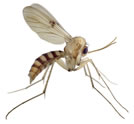A major effort in the quest to complete the FLYTREE research for the second tier of taxa has been to search the globe for representatives of each fly family so that fresh material can be used for DNA sequencing and morphological scoring. The project has often relied on our collaborators, who are scattered around the world, to obtain members of critical, localized families. One such family, the Perissommatidae (see Figures) had eluded the Australian FLYTREE team for the first few years of the grant. The family is only known from a handful of species found in southeastern Australia and Chile. Specimens are uncommon in collections, but the type locality of one species in this family is close to Canberra, Australia, based on specimens collected by Don Colless in the southern hemisphere winter over 40 years ago. Morphological data has not provided compelling evidence for the phylogenetic position of Perissommatidae, and no recent material had been collected for further studies. The adults have broad, mottled wings and bizarre compound eyes divided into separate dorsal and ventral sections.
Establishing the phylogenetic position of the Perissommatidae in the Lower Diptera is an important goal of FLYTREE. The Australian FLYTREE team searched the type locality for two years in a row without success, and began to believe that the extended drought conditions in Australia may have caused a local extinction of the species. However, a volunteer in the Diptera section of the Australian National Insect Collection, David Ferguson, came to the rescue. He established a winter Malaise trapping program in Tallaganda National Park, part of a range of mountains just to the east of Canberra, to snare the elusive Perissomma. In July 2006, David found a series of adults of Perissomma mcalpinei in a trap placed in a tall, moist woodland forest at 1150 m altitude. Subsequently, numerous adults were hand netted at the site. Specimens preserved in 100% ethanol were sent to Brian Wiegmann’s lab at North Carolina State University, and his Ph.D. student, Matt Bertone, obtained DNA sequences and by the end of July 2006, he was able to place the Perissommatidae in his molecular phylogenetic analysis of the Lower Diptera. Matt will be publishing his results in 2007, and The Australian Entomologist has just accepted a paper by David Ferguson, reporting on the behavioural observations of adult Perissommatidae.
This example demonstrates how much we rely on the energy and enthusiasm of FLYTREE collaborators. Great work, Dave!!
Submitted by David K. Yeates, Co-PI on FLYTREE, Assembling the Tree of Life for Diptera.
Subscribe to:
Post Comments (Atom)

No comments:
Post a Comment